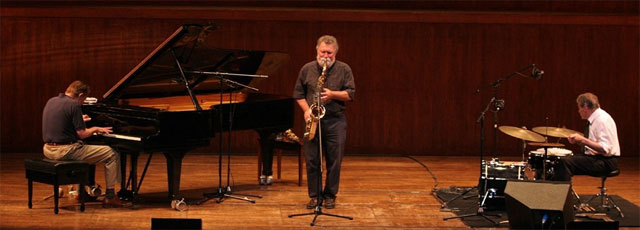Alexander von Schlippenbach’s most reliable signature is the emphatic bass note with which he initiates an improvisation. Even though it rarely has time to decay before the pianist adds a jarring cluster or another musician jumps in, this stentorian note establishes not only the tonal gravity of what is to come, but it is emblematic of Schlippenbach’s gravitas as an improviser. Schlippenbach used this device to launch the performances of Globe Unity Orchestra and Schlippenbach Trio at this year’s edition of Jazz Em Agosto in Lisbon. The ensuing trajectories of the respective concerts, however, were determined roughly equally by every musician.
Within a second or two of Schlippenbach’s ignition of Globe Unity’s concert in the Anfiteatro ao Ar Livre, bass clarinetist Rudi Mahall made it clear that, as one of the newest members, he was taking a back seat to no one. Backed by only Schlippenbach and the churning pulse of drummers Paul Lovens and Paul Lytton, Mahall leaped through his instrument’s registers, his low notes grumbling and his high notes crying to create the semblance of antiphony. A long-time member of Globe Unity and a contributor to Schlippenbach’s other early manifesto-like project, the 1969 sextet session, The Living Music (FMP), trombonist Paul Rutherford played off this aspect of Mahall’s playing, and laid down a sleek counter line. In rapid succession, trombonist Johannes Bauer entered roaring, and clarinetist Ernst-Ludwig Petrowsky came in, capping the ensemble with piercing high notes. This opened the floodgates for the first of several explosive ensembles (a Globe Unity tutti should probably be measured by the Richter scale rather than in Decibels).
As the tutti subsided, tenor saxophonists Gerd Dudek and Evan Parker figuratively locked horns. Their respective styles represent two distinct branches of John Coltrane’s legacy. Dudek’s hard-edged tone is more directly linked to Coltrane’s sound with the classic quartet than Parker’s more textured attack. Both have moorings in the motivic development Coltrane employed in the mid-‘60s, but Dudek is more arpeggio-centric than Parker, who leans more heavily and more quickly into the cries Coltrane all but patented. However, they both value the culminating moment in every great Coltrane solo, the step onto the summit that opens the skies. Approaching from different angles, Dudek and Parker hit this spot at the same time and the energy of the music spiked. A staggered entrance by several musicians followed, with trumpeter Manfred Schoof’s thrilling chops being the catalyst for a second tutti.
In some aspects, the horns in Globe Unity’s ensembles approximated the functions of horn sections in traditional jazz orchestras. Globe Unity’s reeds laid the foundation with a rumbling mass of sound, which the slide-wielding Bauer and Rutherford repeatedly sliced to create mounting tension. At the optimum moment, Schoof and trumpeter Jean-Luc Cappozzo swooped in with soaring long notes and pyrotechnics to create what would ordinarily be a memorable apex. However, the similarities with big band conventions end there; instead of a tidy climax, Globe Unity instead establishes a new baseline of intensity that they immediately ratchet up another notch.







